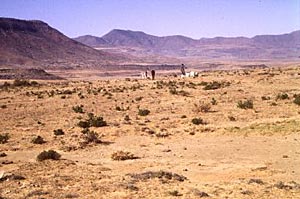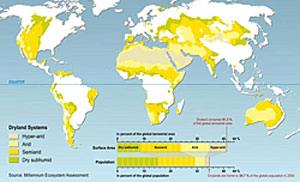|
By Karen Goldberg, Drynet
 What is desertification? What is desertification?
To some of us, the term “desertification” conjures up images of the Sahara desert eating its way into arable, vegetated lands. However, this is a misinterpretation of the word. Desertification is not the spread of existing deserts: it is the destruction or degradation of productive land in dry areas mainly because of misuse or overuse.
The recent Millennium Ecosystem Assessment estimates that desertification directly affects more people than any other global environmental problem facing the international community.
Degradation of drylands over vast areas of the globe has enormous economic, social and ecological implications, especially in developing countries. They face erosion, famine, migration, water shortages, declining soil fertility, decreasing farm profits and – in the worst cases – displacement of entire rural communities. Yet, desertification remains one of the most disappointing policy and scientific failures of global environmental efforts.
What is causing this problem?
Many factors contribute to desertification, but overall the problem is caused by humans placing too much pressure on fragile ‘dryland’ ecosystems. Land degradation of this sort happens in hot and dry areas of the world where the soil is already fragile. Overgrazing, intensive arable farming and deforestation are some of the main causes of desertification.
The most vulnerable continent to desertification is Africa. About 60% of its total area is covered by deserts or drylands. Most African communities rely on agriculture for their livelihoods, with many farming on marginal lands. The continent already bears the greatest burden of poverty and land degradation in the world. Activities that take place in the developed economies can also indirectly affect the livelihood of these distant communities due to the global impacts of climate change and desertification.
Desertification and climate change threats to South Africa
More than ninety percent of South Africa can be classified as “dryland” and is therefore at risk of land degradation and desertification. Some of the most vulnerable regions are the areas around the edges of the Kalahari Desert and some regions in the Karoo.
South Africa’s dryland areas have been put under strain by unsustainable agricultural practices such as overgrazing, which can often be traced back to the inequitable land distribution and development policies of the apartheid era.
 In addition to these problems, South Africa is already beginning to experience the impacts of climate change. Climate scientists agree that the western parts of South Africa will be severely affected by higher temperatures and a range of other impacts including lower average rainfall. The dryer area of the Succulent Karoo and the Fynbos biomes will be particularly badly affected, and it is predicted that large areas will become desert.South Africa is a signatory to the United Nations Convention to Combat Desertification (UNCCD) and has taken the first step in developing a National Action Programme outlining how its commitments under this convention will be met. The UNCCD (adopted in 1994) is the centerpiece of the international community’s efforts to combat desertification and land degradation in the drylands. The UNCCD explicitly recognizes the importance of involving local communities in combating desertification and land degradation. In addition to these problems, South Africa is already beginning to experience the impacts of climate change. Climate scientists agree that the western parts of South Africa will be severely affected by higher temperatures and a range of other impacts including lower average rainfall. The dryer area of the Succulent Karoo and the Fynbos biomes will be particularly badly affected, and it is predicted that large areas will become desert.South Africa is a signatory to the United Nations Convention to Combat Desertification (UNCCD) and has taken the first step in developing a National Action Programme outlining how its commitments under this convention will be met. The UNCCD (adopted in 1994) is the centerpiece of the international community’s efforts to combat desertification and land degradation in the drylands. The UNCCD explicitly recognizes the importance of involving local communities in combating desertification and land degradation.
Rising to the challenge: Drynet, giving future to drylands
The impacts of climate change and desertification are predicted to fall disproportionately on the poor, who rely most heavily on this environment for their livelihoods and who are least able to adapt. We can no longer afford to ignore these problems if we are to achieve the goals of poverty eradication and development.
At the local level communities are already facing the threats of land degradation and climate change, and are beginning to develop strategies for coping with these challenges. A key solution lies in making maximum use of strategies to address climate change and desertification simultaneously, by learning from the experience gained in tackling land degradation in dryland areas, and by mainstreaming both challenges into development policies across all sectors.
Drynet is taking up this challenge. In June 2007, 14 organisations from around the world launched this joint initiative. This EU-funded project aims to strengthen civil society networks such as farmers’ collectives; indigenous groups; women’s organisations; trade unions and non-governmental organisations, providing them with the knowledge and skills to influence dryland development policies in affected countries. The ultimate goal of Drynet is to provide key stakeholders, including scientists and policy makers, with an urgently needed practical response to combat land degradation by linking local action to global opportunities. By putting dryland and related poverty issues higher on the political agenda, Drynet aims to stimulate and promote sustainable development.
Drynet South Africa has started gathering momentum in recent months. To date, we have about 65 civil society organisations (CSOs) on our national database working with or interested in tackling desertification, ranging from farmers’ organisations and NGOs to academic and research institutions. We offer all on our database the opportunity to receive and contribute to our regular newsletters.
Other current and planned activities for Drynet South Africa over the coming months include the identification and dissemination of sustainable land management (SLM) best practices, coordinating and producing a series of radio programmes on desertification and dryland development, and the hosting of a national civil society workshop, from the 17th – 19th June (to coincide with the International Day of Desertification). The aim of this workshop includes sharing research, knowledge and best practices and contributing towards mainstreaming UNCCD and SLM in policy dialogue and development strategy frameworks.
For more information on Drynet activities in South Africa, or to find out how your organisation can get involved, contact Karen Goldberg.
Sources:
Millennium Ecosystem Assessment:
http://www.millenniumassessment.org/en/index.aspx
Drylands, deserts and desertification conference, 2008:
http://cmsprod.bgu.ac.il/Eng/Units/bidr/desertification2008/
The environmental Monitoring Group:
www.emg.org.za
South African National Action Plan:
http://www.unccd.int/actionprogrammes/africa/national/2004/south_africa-eng.pdf
DEAT press release:
http://www.environment.gov.za/HotIssues/2007/UNCCD/03092007.html
|